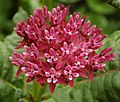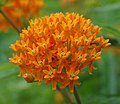Asclepias: Difference between revisions
I gave important feedback that will help improve this site by informing the audience of a poorly taken and unhelpful phot Tags: Visual edit Mobile edit Mobile web edit |
|||
| Line 49: | Line 49: | ||
Asclepias species produce some of the most complex flowers in the plant kingdom, comparable to [[orchids]] in complexity. Five petals reflex backwards revealing a gynostegium (fused stamen filamens and styles) surrounded by a five-membered corona. The corona is composed of a five paired hood and horn structures with the hood acting as a sheath for the inner horn. Glands holding pollinia are found between the hoods. The size, shape and color of the horns and hoods are often important identifying characteristics for species in the genus Asclepias.<ref>http://orbisec.com/milkweed-flower-morphology-and-terminology/ Milkweed Flower Morphology</ref> |
Asclepias species produce some of the most complex flowers in the plant kingdom, comparable to [[orchids]] in complexity. Five petals reflex backwards revealing a gynostegium (fused stamen filamens and styles) surrounded by a five-membered corona. The corona is composed of a five paired hood and horn structures with the hood acting as a sheath for the inner horn. Glands holding pollinia are found between the hoods. The size, shape and color of the horns and hoods are often important identifying characteristics for species in the genus Asclepias.<ref>http://orbisec.com/milkweed-flower-morphology-and-terminology/ Milkweed Flower Morphology</ref> |
||
[[Pollination]] in this genus is accomplished in an unusual manner. [[Pollen]] is grouped into complex structures called [[pollinia]] (or "pollen sacs"), rather than being individual grains or tetrads, as is typical for most plants. The feet or mouthparts of flower-visiting insects such as [[bee]]s, [[wasp]]s and [[Butterfly|butterflies]], slip into one of the five slits in each flower formed by adjacent [[anther]]s. The bases of the pollinia then mechanically attach to the insect, so that a pair of pollen sacs can be pulled free when the pollinator flies off, assuming the insect is large enough to produce the necessary pulling force (if not, the insect may become trapped and die).<ref name = "Robertson">Robertson, C. (1887) Insect relations of certain asclepiads. I. Botanical Gazette 12: 207–216</ref> Pollination is effected by the reverse procedure in which one of the pollinia becomes trapped within the anther slit. |
[[Pollination]] in this genus is accomplished in an unusual manner. [[Pollen]] is grouped into complex structures called [[pollinia]] (or "pollen sacs"), rather than being individual grains or tetrads, as is typical for most plants. The feet or mouthparts of flower-visiting insects such as [[bee]]s, [[wasp]]s and [[Butterfly|butterflies]], slip into one of the five slits in each flower formed by adjacent [[anther]]s. Milkweed is particularly used commonly as a food source by the bumblebee, [[Bombus terricola]]. The bases of the pollinia then mechanically attach to the insect, so that a pair of pollen sacs can be pulled free when the pollinator flies off, assuming the insect is large enough to produce the necessary pulling force (if not, the insect may become trapped and die).<ref name = "Robertson">Robertson, C. (1887) Insect relations of certain asclepiads. I. Botanical Gazette 12: 207–216</ref> Pollination is effected by the reverse procedure in which one of the pollinia becomes trapped within the anther slit. |
||
[[File:Bee on Antelope Horn-April 2015.JPG|thumb|Honeybee on antelope horn (''[[Asclepias asperula]]'') with pollinia attached to legs]] |
[[File:Bee on Antelope Horn-April 2015.JPG|thumb|Honeybee on antelope horn (''[[Asclepias asperula]]'') with pollinia attached to legs]] |
||
''Asclepias'' species produce their [[seed]]s in [[Follicle (fruit)|follicles]]. The seeds, which are arranged in overlapping rows, bear a cluster white, silky, filament-like hairs known as the '''coma'''<ref>Sacchi, C.F. (1987) Variability in dispersal ability of Common Milkweed, ''Asclepias syriaca'', seeds, [[Oikos]] Vol. 49, pp. 191-198</ref> (often referred to by other names such as [[Pappus (flower structure)|pappus]], "floss", "plume", or "silk"). The follicles ripen and split open, and the seeds, each carried by its coma, are blown by the [[Seed dispersal#Wind|wind]]. |
''Asclepias'' species produce their [[seed]]s in [[Follicle (fruit)|follicles]]. The seeds, which are arranged in overlapping rows, bear a cluster white, silky, filament-like hairs known as the '''coma'''<ref>Sacchi, C.F. (1987) Variability in dispersal ability of Common Milkweed, ''Asclepias syriaca'', seeds, [[Oikos]] Vol. 49, pp. 191-198</ref> (often referred to by other names such as [[Pappus (flower structure)|pappus]], "floss", "plume", or "silk"). The follicles ripen and split open, and the seeds, each carried by its coma, are blown by the [[Seed dispersal#Wind|wind]]. |
||
== Ecology == |
== Ecology == |
||
Revision as of 08:02, 4 November 2015
| Asclepias | |
|---|---|

| |
| Asclepias syriaca showing flowers and latex. | |
| Scientific classification | |
| Kingdom: | |
| (unranked): | |
| (unranked): | |
| (unranked): | |
| Order: | |
| Family: | |
| Subfamily: | |
| Tribe: | |
| Subtribe: | |
| Genus: | Asclepias |
| Type species | |
| Asclepias syriaca L.
| |
| Species | |
|
See text. | |
| Synonyms[1] | |



Asclepias L. (1753), the milkweeds, is an American genus of herbaceous perennial, this lower picture is the worst picture ever taken!) plants that contains over 140 known species. It previously belonged to the family Asclepiadaceae, but this is now classified as the subfamily Asclepiadoideae of the dogbane family Apocynaceae.
Milkweed is named for its milky sap, which consists of a latex containing alkaloids and several other complex compounds including cardenolides.[2] Some species are known to be toxic.
Carl Linnaeus named the genus after Asclepius, the Greek god of healing, because of the many folk-medicinal uses for the milkweed plants.
Milkweed flowers
Asclepias species produce some of the most complex flowers in the plant kingdom, comparable to orchids in complexity. Five petals reflex backwards revealing a gynostegium (fused stamen filamens and styles) surrounded by a five-membered corona. The corona is composed of a five paired hood and horn structures with the hood acting as a sheath for the inner horn. Glands holding pollinia are found between the hoods. The size, shape and color of the horns and hoods are often important identifying characteristics for species in the genus Asclepias.[3]
Pollination in this genus is accomplished in an unusual manner. Pollen is grouped into complex structures called pollinia (or "pollen sacs"), rather than being individual grains or tetrads, as is typical for most plants. The feet or mouthparts of flower-visiting insects such as bees, wasps and butterflies, slip into one of the five slits in each flower formed by adjacent anthers. Milkweed is particularly used commonly as a food source by the bumblebee, Bombus terricola. The bases of the pollinia then mechanically attach to the insect, so that a pair of pollen sacs can be pulled free when the pollinator flies off, assuming the insect is large enough to produce the necessary pulling force (if not, the insect may become trapped and die).[4] Pollination is effected by the reverse procedure in which one of the pollinia becomes trapped within the anther slit.

Asclepias species produce their seeds in follicles. The seeds, which are arranged in overlapping rows, bear a cluster white, silky, filament-like hairs known as the coma[5] (often referred to by other names such as pappus, "floss", "plume", or "silk"). The follicles ripen and split open, and the seeds, each carried by its coma, are blown by the wind.
Ecology
American milkweeds are an important nectar source for native bees, wasps, and other nectar-seeking insects, though non-native honey bees commonly get trapped in the stigmatic slits and die,[4][6] and a larval food source for monarch butterflies and their relatives, as well as a variety of other herbivorous insects (including numerous beetles, moths, and true bugs) specialized to feed on the plants despite their chemical defenses.
Milkweeds use three primary defenses to limit damage caused by caterpillars: hairs on the leaves, cardenolide toxins, and latex fluids. Data from a DNA study indicate that more recently evolved milkweed species use these preventative strategies less but grow faster than older species, potentially regrowing faster than caterpillars can consume them.[7]
Uses
The milkweed filaments from the coma (the "floss") are hollow and coated with wax, and have good insulation qualities. During World War II, over 5,000 t (5,500 short tons) of milkweed floss were collected in the United States as a substitute for kapok.[8][9] As of 2007, milkweed is grown commercially as a hypoallergenic filling for pillows.[10] A study of the insulative properties of various materials found that milkweed floss was outperformed by other materials in insulation, loft, and lumpiness, but scored well on various metrics when mixed with down feathers.[11] Milkweed fibers are used to clean up oil spills.[12]

In the past, the high dextrose content of the nectar led to milkweed's use as a source of sweetener for Native Americans and voyageurs.
The bast fibers of some species can be used for cordage.
Milkweed latex contains about 1 to 2% latex, and was attempted as a source of natural rubber by both Germany and the United States during World War II. No record has been found of large-scale success.
Milkweed is beneficial to nearby plants, repelling some pests, especially wireworms.
Milkweed also contains cardiac glycoside poisons that inhibit animal cells from maintaining a proper K+, Ca+ concentration gradient.[citation needed] As a result, many natives of South America and Africa used arrows poisoned with these glycosides to fight and hunt more effectively. Milkweed is toxic and may cause death when animals consume 10% of their body weight in any part of the plant.[citation needed] Milkweed also causes mild dermatitis in some who come in contact with it.
The leaves of Asclepias species, and of some species formerly classified as Asclepias such as Gomphocarpus physocarpus, are the only food source for monarch butterfly larvae and other milkweed butterflies. These plants are therefore often used in butterfly gardening.[citation needed]
Species
Some Asclepias species:
 |
Asclepias albicans | Whitestem milkweed, native to the Mojave and Sonoran deserts |
 |
Asclepias amplexicaulis | Blunt-leaved milkweed, native to central and eastern United States |
 |
Asclepias asperula | Antelope horns, native to American southwest and northern Mexico |
 |
Asclepias californica | California milkweed, native to central and southern California |
 |
Asclepias cordifolia | Heart-leaf milkweed, native to the Sierra Nevada and Cascade Range up to 2000 m. |
 |
Asclepias cryptoceras | Pallid milkweed, native to the western United States. |
 |
Asclepias curassavica | Scarlet milkweed, tropical milkweed, bloodflower, bastard ipecacuanha, native to the American tropics, introduced to other continents |
 |
Asclepias curtissii | Curtiss' milkweed, endemic to sandy areas of Florida |
 |
Asclepias eriocarpa | Woollypod milkweed, native to California, Baja California, and Nevada |
 |
Asclepias erosa | Desert milkweed, native to California, Arizona, and Baja California |
 |
Asclepias exaltata | Poke milkweed, native to eastern North America |
 |
Asclepias fascicularis | Narrow-leaf milkweed, native to Western United States |
 |
Asclepias humistrata | Sandhill milkweed, native to southeastern United States |
 |
Asclepias incarnata | Swamp milkweed, native to wetlands of North America |
 |
Asclepias lanceolata | Lanceolate milkweed (Cedar Hill milkweed), native to coastal plain of eastern United States from Texas to New Jersey |
 |
Asclepias linaria | Pine needle milkweed, native to Mojave and Sonoran deserts |
| Asclepias linearis | Slim milkweed | |
 |
Asclepias longifolia | Longleaf milkweed |
 |
Asclepias meadii | Mead's milkweed, native to midwestern United States |
 |
Asclepias nyctaginifolia | Mojave milkweed, native to the American southwest |
| Asclepias obovata | Pineland milkweed | |
 |
Asclepias purpurascens | Purple milkweed, native to eastern, southern, and midwestern United States |
 |
Asclepias quadrifolia | Four-leaved milkweed, native to eastern United States and Canada |
 |
Asclepias rubra | Red milkweed |
 |
Asclepias solanoana | Serpentine milkweed, native to northern California |
 |
Asclepias speciosa | Showy milkweed, native to western United States and Canada |
 |
Asclepias subulata | Rush milkweed, leafless milkweed, native to southwestern North America |
 |
Asclepias subverticillata | Horsetail milkweed[13] |
 |
Asclepias sullivantii | Sullivant's milkweed |
 |
Asclepias syriaca | Common milkweed |
 |
Asclepias tuberosa | Butterfly weed, pleurisy root |
 |
Asclepias uncialis | Wheel milkweed |
 |
Asclepias variegata | White milkweed |
 |
Asclepias verticillata | Whorled milkweed |
| Asclepias vestita | Woolly milkweed | |
 |
Asclepias viridiflora | Green milkweed |
 |
Asclepias viridis | Green antelopehorn, spider milkweed |
 |
Asclepias welshii | Welsh's milkweed |
Formerly placed here
Some species formerly classified under the Asclepias genus include:
- Calotropis gigantea (L.) W.T.Aiton (as A. gigantea L.)
- Calotropis procera (Aiton) W.T.Aiton (as A. procera Aiton)
- Cynanchum louiseae Kartesz & Gandhi (as A. nigra L.)
- Cynanchum thesioides (Freyn) K.Schum. (as A. sibirica L.)
- Funastrum clausum (Jacq.) Schltr. (as A. clausa Jacq.)
- Gomphocarpus cancellatus (Burm.f.) Bruyns (as A. cancellatus Burm.f. or A. rotundifolia Mill.)
- Gomphocarpus fruticosus (L.) W.T.Aiton (as A. fruticosa L.)
- Marsdenia macrophylla (Humb. & Bonpl. ex Willd.) E.Fourn. (as A. macrophylla Humb. & Bonpl. ex Schult.)
- Marsdenia tenacissima (Roxb.) Moon (as A. tenacissima Roxb.)
- Matelea maritima (Jacq.) Woodson (as A. maritima Jacq.)
- Sarcostemma acidum (Roxb.) Voigt (as A. acida Roxb.)
- Sarcostemma viminale (L.) R.Br. (as A. viminalis (L.) Steud.)
- Telosma cordata (Burm.f.) Merr. (as A. cordata Burm.f.)
- Telosma pallida (Roxb.) Craib (as A. pallida Roxb.)
- Tylophora indica (Burm.f.) Merr. (as A. asthmatica L.f.)
- Vincetoxicum hirundinaria Medik. (as A. vincetoxicum L.)
- Vincetoxicum pycnostelma Kitag. (as A. paniculata Bunge)
- Xysmalobium undulatum (L.) R.Br. (as A. undulata L.)[14]
References
- ^ a b "Taxon: Asclepias L." Germplasm Resources Information Network. United States Department of Agriculture. 2003-03-13. Retrieved 2013-02-05.
- ^ Singh, B. and Rastogi, R.P. (1970). Cardenolides-glycosides and genins. Phytochemistry 9: 315-331.
- ^ http://orbisec.com/milkweed-flower-morphology-and-terminology/ Milkweed Flower Morphology
- ^ a b Robertson, C. (1887) Insect relations of certain asclepiads. I. Botanical Gazette 12: 207–216
- ^ Sacchi, C.F. (1987) Variability in dispersal ability of Common Milkweed, Asclepias syriaca, seeds, Oikos Vol. 49, pp. 191-198
- ^ Frost, S.W. (1965) Insects and pollinia. Ecology 46: 556–558
- ^ Ramanujan, Krishna (Winter 2008). "Discoveries: Milkweed evolves to shrug off predation". Northern Woodlands. 15 (4). Center for Northern Woodlands Education: 56.
- ^ Hauswirth, Katherine (2008-10-26). "The Heroic Milkweed". The Christian Science Monitor. Retrieved 2014-02-14.
- ^ Wykes, Gerald (2014-02-04). "A Weed Goes to War, and Michigan Provides the Ammunition". MLive Media Group. Michigan History Magazine. Retrieved 2014-02-14.
- ^ Evangelista, R.L. (2007). "Milkweed seed wing removal to improve oil extraction". Industrial Crops and Products. 25 (2): 210–217. doi:10.1016/j.indcrop.2006.10.002.
- ^ McCullough, Elizabeth A. (April 1991). "Evaluation of Milkweed Floss as an Insulative Fill Material". Textile Research Journal. 61 (4): 203–210. doi:10.1177/004051759106100403.
- ^ http://www.cbc.ca/news/politics/milkweed-touted-as-oil-spill-super-sucker-with-butterfly-benefits-1.2856029
- ^ Asclepias subverticillata (A. Gray) Vail, USDA PLANTS
- ^ "GRIN Species Records of Asclepias". Germplasm Resources Information Network. United States Department of Agriculture. Retrieved 2011-02-22.
- Everitt, J.H.; Lonard, R.L.; Little, C.R. (2007). Weeds in South Texas and Northern Mexico. Lubbock: Texas Tech University Press. ISBN 0-89672-614-2
External links
